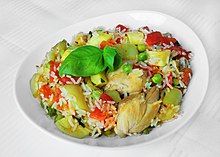


Parboiled rice, also called converted rice, easy-cook rice,[1] sella rice, and miniket (as predominantly called in West Bengal and Odisha in India, and in Bangladesh) is rice that has been partially boiled in the husk. The three basic steps of parboiling are soaking, steaming and drying.[2] These steps make the rice easier to process by hand, while also boosting its nutritional profile, changing its texture, and making it more resistant to weevils.[3] The treatment is practiced in many other parts of the world.[4]
Parboiling drives nutrients, especially thiamine, from the bran to the endosperm, hence parboiled white rice is mostly nutritionally similar to brown rice.[5] Given the pale tan color that results from these bran components, parboiled rice is sometimes called saffron sella.
- ^ "Types of rice – Rice Association". www.riceassociation.org.uk. Archived from the original on 25 November 2020.
- ^ Miah, M. A. Kaddus; Haque, Anwarul; Douglass, M. Paul; Clarke, Brian (2002). "Parboiling of rice. Part II: Effect of hot soaking time on the degree of starch gelatinization". International Journal of Food Science and Technology. 37 (5): 539–545. doi:10.1046/j.1365-2621.2002.00611.x.
- ^ Kik, M.C.; Williams, R.R. (June 1945). "The Nutritional Improvement of White Rice". Bulletin of the National Research Council. 112: 61–.
- ^ Pillaiyar, P. (1981). Household parboiling of parboiled rice. Kishan World, 8, 20–21.
- ^ Kyritsi, A.; Tzia, C.; Karathanos, V.T. (January 2011). "Vitamin fortified rice grain using spraying and soaking methods". LWT – Food Science and Technology. 44 (1): 312–320. doi:10.1016/j.lwt.2010.06.001.